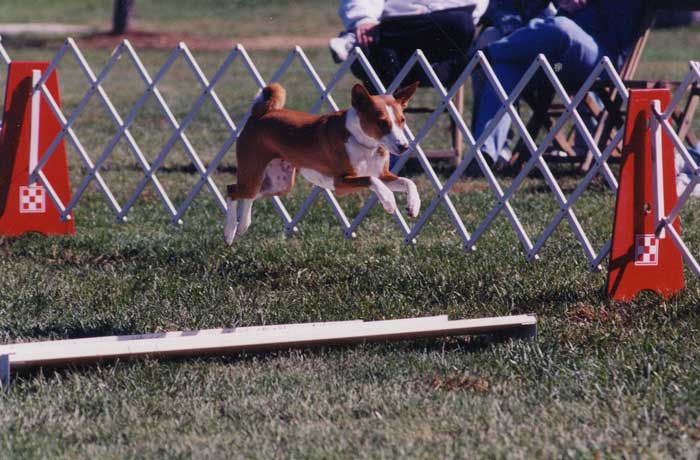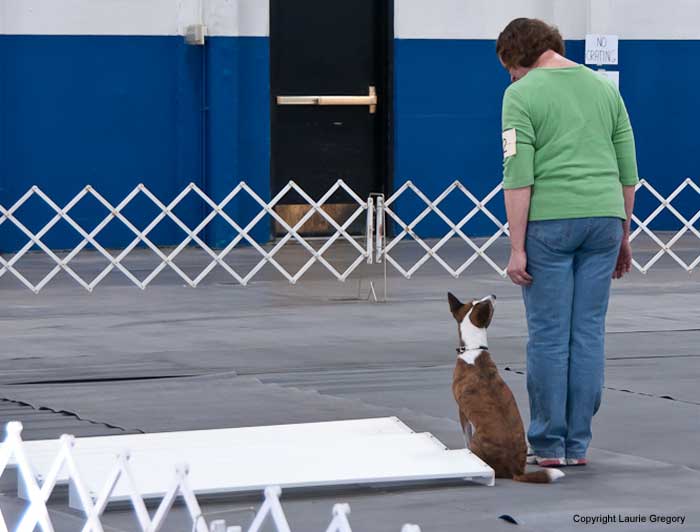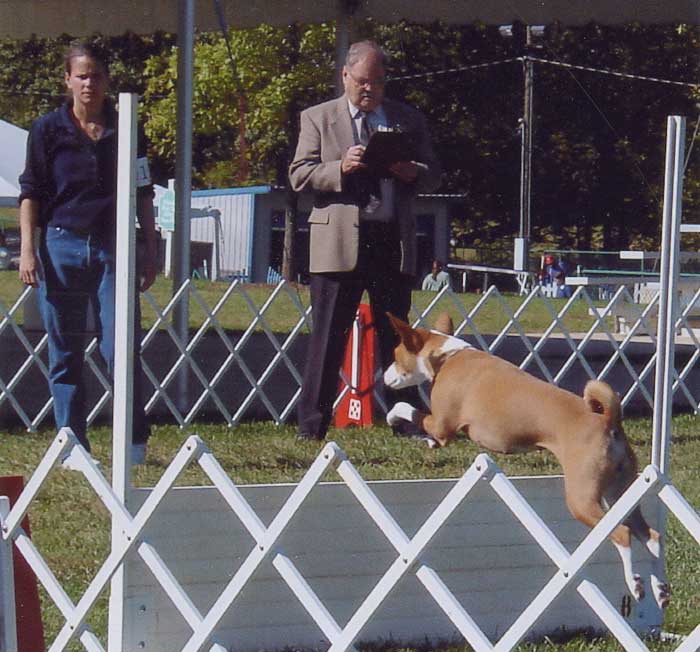The Basenji University
CLICK to return to College of Basenji Activities
205 Exercises

Prepared by Linda Siekert
Jumps
Broad Jump for Open
The broad jump consists of four nesting hurdles which, when spread apart, create a horizontal jump from 8 inches, up to 72 inches, long and no more than 6 inches high at it's highest point. The broad jump distance will be twice the shoulder height of the dog; a 16 inch basenji will jump 32 inches. The dog and handler will face the jump, a minimum of 8 inches away; unlike every other regular obedience jump, the dog will stay where he is while the handler moves into position, which is to the right of the jump, facing the ends of the hurdles, leaving at least 2 feet between them and the jump.
On the judges order the handler will command the dog to jump. With the dog in midair, the handler will make a right pivot in place. The dog can not touch any part of the broad jump and upon landing must make a 180 degree right turn and come in to the handlers’ front. The dog will finish when directed to do so.
In action over the Broad Jump in Open
The dog in heel or "finish" position following the Broad Jump for Katy Scott
Video taken by Purebred Studios at the 2010 BCOA National Specialty.
Directed Jumping for Utility
There are two identical components to the Directed Jumping exercise, the only difference being the type of jumps.
The solid panel high jump is identical to the high jump in Open. The Bar Jump is a square bar, 5 feet in length. The bar is alternately painted black and white with wide sections, and sits atop 4 foot high uprights. The bar must be "wood heavy" but be light enough for a dog that does not fully clear the jump to knock it off the uprights. The bar must be placed in such a way that the uprights themselves are not affected by the dropped bar and remain in place. The jump height for both will be set close to shoulder height (16 inches for basenjis under 17 inches tall).
Directed High Jump in Utility for Linda Siekert
Go Out/Directed Jumping (Utility)
If the ring were the face of a clock the dog and handler will be in the 6 o'clock position close to the ring ropes. The jumps will be positioned parallel to the handler 20 feet away and will be 20 feet from each other, one at 3 o'clock, and the other at 9 o'clock. Upon the judge's order the handler will send the dog due north toward 12 o'clock, between the jumps, to the other end of the ring. Once the dog is approximately 20 feet beyond the jumps, the handler will command the dog to sit. This is called the “Go Out” portion of the exercise. The dog is expected to turn, squarely face the handler and sit, at which time the judge will order either "High" or "Bar". The handler will issue a command and/or signal for the dog to take the specific jump and return to the handlers’ front. After finishing, the exercise is repeated, using the opposite jump.
Go Out/Directed Jumping for Graduate Open
In this class the two components of directed jumping described above are broken into two separate exercises; Go Out and Directed Jumping
The Go Out is done exactly as described above except the dog and handler will stand in the center of the ring, between the jumps versus at the far end of the ring. Once the dog has turned back towards the handler and sat, the dog will stay in place while the handler returns to heel position.
For the Directed Jumping exercise the handler will leave the dog at one end of the ring and will walk to the opposite end and turn and face the dog. Upon the judge’s orders the handler will command and/or signal the dog to take the specific jump and return to the handler’s front. Only one jump will be done in this exercise.
NEXT: Signals Return to Exercises Return to Course #205 Obedience and Rally
Copyright the Basenji Club of America 2011 CLICK to return to College of Basenji Activities
Contact the Basenji University with comments, questions, updates and Workbooks at BasenjiU@basenji.org
We are indebted to the Basset Hound Club of America for the use of their Basset Hound University templates.


